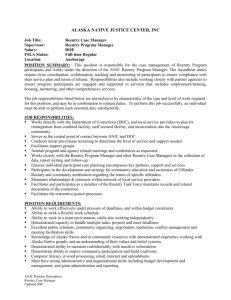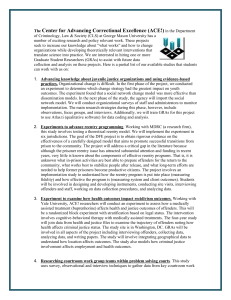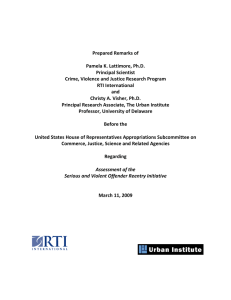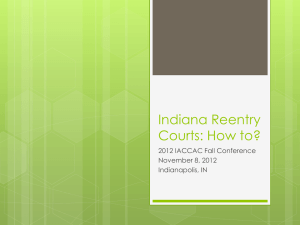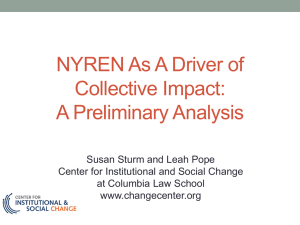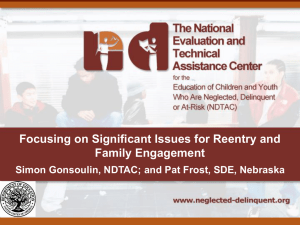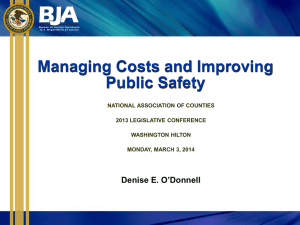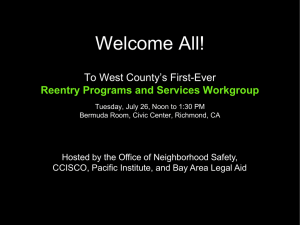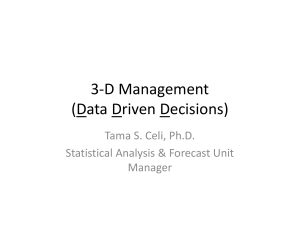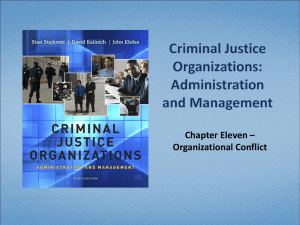Capacity Building Outline - Alameda County Government
advertisement
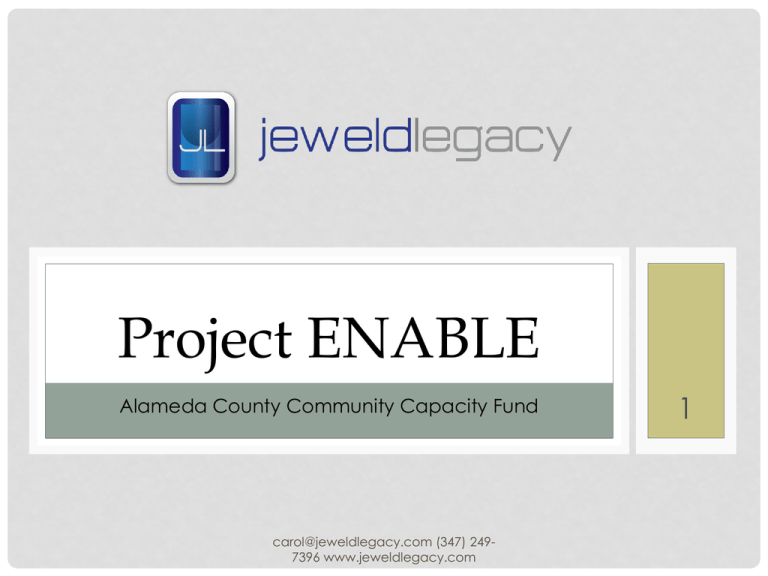
Project ENABLE Alameda County Community Capacity Fund carol@jeweldlegacy.com (347) 2497396 www.jeweldlegacy.com 1 IDENTIFIED CHALLENGES FOR ORGANIZATIONS SERVING THE REENTRY POPULATION • Restricted Funding Sources • Performance Measurements and Program Evaluation inconsistent and/or absent • Few resources dedicated to evidence-based models best practices in the field • Inadequate Infrastructure • Limited formal knowledge regarding Non Profit Management • Insufficient Resources for Staff Development/Training • Limited knowledge of industry “Game Changers” or proactive approaches carol@jeweldlegacy.com (347) 2497396 www.jeweldlegacy.com 2 CHARACTERISTICS OF A SUSTAINABLE REENTRY ORGANIZATION (INFRASTRUCTURE) Adequate Infrastructure Support Program Evaluation and Performance Measures Anticipates Industry and Environmental GAME CHANGERS Diversification of Funding Fundraising On going Financial Analysis and Forecasting 3 CHARACTERISTICS OF A SUSTAINABLE REENTRY ORGANIZATION (DEVELOPMENT) Effective Board of Directors Succession Planning Hires and trainings formerly incarcerated staff members Mentoring/Coaching Leadership Staff Development 4 CHARACTERISTICS OF SUSTAINABLE REENTRY ORGANIZATIONS (PROGRAM DESIGN) Trauma Informed Approach Cultural Awareness and Competency Understands the culture of corrections Strong knowledge and experience working with population and their families 5 GOAL OF PROJECT ENABLE TO IMPROVE THE CAPACITY OF ORGANIZATIONS TO DELIVER EFFECTIVE SERVICES TO THE REENTRY POPULATION LIVING IN ALAMEDA COUNTY 6 CONCEPT TO BUILD CAPACITY Additional Funding Technical Assistance Training Improved Capacity OF COUNTY AGENCIES HOW IT WORKS Training Technical Assistance Capacity Building RESOURCES/GRANTS 8 FOUR AREAS OF FOCUS Merger/Acquisitions/ Strategic Partnerships Evaluation and Performance Program Design and Implementation Organizational Development 9 TRAINING AREAS Leadership/ Staff Development Financial Management Program Design & Implementa tion Evidence Based Models AND EVALUATION Special Populations Cultural Relevance and Competency 10 TRAINING AREAS Cultural Relevance/Competency Evidence Based Models and Performance Measures Financial Management Special Populations Program Design and Implementation Leadership/Staff Development 11 SUGGESTED TRAINING TOPICS Working with Criminal Justice Involved Clients and their Families, Part 1 and Part 2 What’s New in the World of Reentry: Emerging Trends, Challenges and Solutions ABC’s of Contracting with County Agencies Affordable Care Act: A Game Changer for Agencies Serving the Criminal Justice Population 12 SUGGESTED TRAINING TOPICS Culture of Corrections: Working in Prisons and Jails Gender Responsive Programs: What does it Really Mean? Crime Victims: Integrating their Voices Restorative Justice Principals and Models The Impact of the Criminal Justice System on Children and Families Mental Health and Substance Abuse Interventions 13 SUGGESTED TRAINING TOPICS Introduction to Non Profit Financial Management Strategic Restructuring: To Merge or Not Grant writing 101: What Are Funders Really Looking For? Performance Measurements and Why They Matter The Essentials of Criminal Justice and Reentry Leadership 14 SUGGESTED TRAINING TOPICS What Works: Evidenced Based Interventions for Criminal Justice Populations Program Evaluation: Necessary or Just Evil Measuring Recidivism and Success Social Impact Bonds and Pay for Success Hiring Criminal Justice Involved Staff 15 IMPLEMENTATION APPROACH • Outreach and Marketing • Training: Knowledge Building topics that appeal to a wider audience via PHASE ONE presentations, workshops and webinars • Gather existing data regarding needs of population, organizations and government agencies • Training: Specific topics address evidence based interventions, evaluation, special populations, sustainability and other topics generated in phase one PHASE TWO • Applications for Funding Developed and Issued • Technical Assistance(agency assessments, clinics etc) • Grants awarded in the amounts of $25,000-$100,000 • Technical Assistance: Agency assessment, on going assistance, PHASE THREE monitoring and evaluation • LIMITED TO 25-35 GRANTEES selected through Application Process 16 WHO IS ELIGIBLE FOR CCF? • CB/FB/GR Organizations serving or potential to serve AB109 Population Phase 1 Phase 2 • Everyone from Phase 1 is eligible • Everyone from Phase 1 and Phase 2 are eligible to apply Phase 3 17 REQUEST FOR FUNDING • Proposals and application process will be simple and straightforward(similar to the Innovation Fund) • Proposals must include a plan to participate in the Capacity Building Evaluation and Technical Assistance Program. • Scored and Evaluated by members from the C.A.B. and County Designees • Quick turnaround and announcement • Awards range from $25,000 - $100,000 • As many at 30 awards annually 18 TIMELINE Timeline Scope and Concept Completed 12/01/2014 Design/Proposal Completed and APPROVED 03/01/2014 Launch and Implementation 04/01/2015 19 POSSIBLE ROLES FOR THE C.A.B. Community Advisory Board Assist in the determination of topics for “Training Modules” Input and participation in the final design Participate in the development of criteria for evaluation and selection of funding awards 20 PROPOSED COMMUNICATION STRUCTURE 21 SOFT BUDGET BREAKDOWN (ONE YEAR ANNUALIZED) 84 % FUNDING TO COMMUNITY AND FAITHBASED ORGANIZATIONS Grants, Trainings/Workshops and Technical Assistance 8 % EVALUATION 8 % IMPLEMENTATION AND COORDINATION 22 POSSIBLE DELIVERABLES Launch February 2015 PHASE ONE 75 organizations will receive training on a variety of topics including evidence based interventions PHASE TWO 35 organizations will receive on-going technical assistance and direct funding PHASE THREE AND BEYOND 50% of the organizations will implement an Evidence Based Intervention 40% will have capacity to report program outcomes www.jeweldlegacy.com PHASE THREE AND BEYOND 30% will develop strategic alliances or partnerships 10-30 % of the organizations will begin the merger and/or acquisition process PHASE THREE AND BEYOND 30% will diversify funding within 18 months 23 JEWELD LEGACY GROUP Successfully operated several small to large non profit organizations serving criminal justice population Extensive experience and knowledge of national models serving CJ populations and their families Content Expert and Trainer for U.S. Department of H.H.S. grantees serving criminal justice populations Well Respected Leader, relationship builder and connector carol@jeweldlegacy.com (347) 2497396 www.jeweldlegacy.com 24 HOW WE DELIVER Highly skilled and diverse team of staff, consultants and affiliated groups Content Experts in the areas of health, law enforcement, reentry, persons personally impacted, non profit management and more Trainings, workshops and webinars are repeated to achieve greater participation Content and delivery methods are refined based continuous feedback from C.A.B., Organizations, County Agencies and Persons Personally Impacted Agency assessments delivered by a comprehensive team Evidence Based Interventions and Promising Practices are accessible carol@jeweldlegacy.com (347) 2497396 www.jeweldlegacy.com 25 OUR PARTNERS National Council on Crime and Delinquency www.nccdglobal.org Angela Irvine The Bridging Group www.thebridginggroup.com Katie Kramer Pendergrass Smith Consulting www.pendergrasssmith.com Sally Smith Leadership Incorporated www.leadershipincorporated.org Frank J. Omowale Satterwhite WeHeartFinance www.weheartfinance.com Stephanie Daniels carol@jeweldlegacy.com (347) 2497396 www.jeweldlegacy.com 26 NEXT STEPS REFINE PLAN WITH INPUT FROM CCPEC, C.A.B., SURVEYS AND EXISTING DATA carol@jeweldlegacy.com (347) 2497396 www.jeweldlegacy.com 27 CAROL F. BURTON, LMSW WWW.JEWELDLEGACY.COM carol@jeweldlegacy.com (347) 2497396 www.jeweldlegacy.com 28
